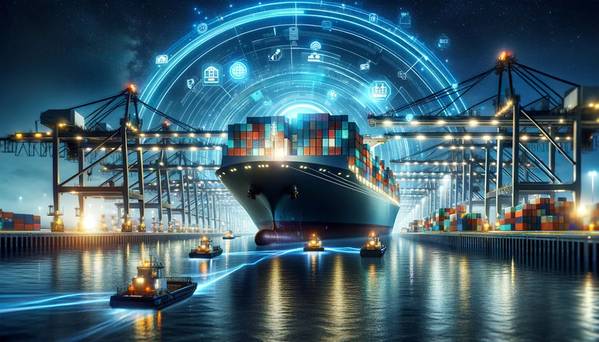Adversarial Seas: AI and the Evolving Cyber Threat in Maritime
By Scott Blough, Strategic Consulting Manager & Taylor Romero, Senior Consultant, Mandiant, Part of Google Cloud
May 7, 2024

Copyright Czintos Ödön/Adobe Stock
The maritime transportation system, the lifeblood of global trade, is undergoing a digital revolution.
Automation and artificial intelligence (AI) are transforming how ships operate and cargo moves. However, this increased reliance on technology creates a double-edged sword: while AI offers powerful tools for cybersecurity, it also presents new vulnerabilities to exploit. This article explores the growing threat of adversarial AI (AAI) in maritime cyber security and how the industry can navigate these challenging waters.
This article is premised on a panel discussion scheduled for the Maritime Risk Symposium 2024, scheduled for June 11-13 at Naval Postgraduate School, Monterey, CA, CLICK HERE for more information and to Register.
AI: Guardian of the Seas
AI is becoming a vital tool in the fight against cybercrime. Here's how it bolsters maritime cyber defenses:
- Enhanced Threat Detection: AI algorithms can analyze vast amounts of data in real-time, identifying subtle anomalies that might indicate a cyberattack in its early stages.
- Proactive Vulnerability Management: AI-powered tools can continuously scan shipboard systems and software for weaknesses, allowing for patching before attackers exploit them.
- Advanced Intrusion Prevention: AI-powered Intrusion Detection and Prevention Systems (IDPS) can learn to recognize the signatures of known cyber threats and even detect zero-day attacks that exploit previously unknown vulnerabilities.
The Dark Tide: Adversarial AI
However, as AI becomes more sophisticated, so do cybercriminals. Adversarial AI (AAI) poses a significant threat to maritime cyber security:
- Bypassing AI Defenses: Malicious actors can craft data specifically designed to deceive AI threat detection systems. For instance, they could manipulate AIS data to make a ship appear legitimate while masking its true intentions.
- Data Poisoning: By manipulating the training data used for AI cybersecurity models, attackers could compromise the models themselves, leading them to overlook real threats or misclassify legitimate activity as malicious.
- Exploiting AI Weaknesses: AAI can identify vulnerabilities in AI-powered security systems, allowing attackers to bypass defenses or gain unauthorized access to critical systems.
Navigating the Grey Zone
The evolving cyber landscape also presents challenges beyond traditional attacks. Grey zone operations blur the lines between legitimate and malicious activity, making them particularly difficult to detect:
- False Flag Attacks: Disguising attacks to appear as if they originate from another nation or entity creates confusion and hampers attribution.
- Information Warfare: Manipulating maritime data, such as falsifying AIS signals, can disrupt navigation or mislead competitors, causing economic damage.
- Supply Chain Infiltration: Targeting vulnerable suppliers upstream can grant attackers access to critical maritime systems further down the line.
Charting a Course to Secure Seas
To combat these threats, the maritime industry needs a multi-pronged approach:
- Adversarial Training: Simulating AAI attacks on AI cybersecurity models to expose vulnerabilities before attackers do.
- Explainable AI: When AI models flag threats, it's crucial to understand their reasoning. Explainable AI techniques can help analysts determine the legitimacy of a threat.
- Human-AI Collaboration: AI should augment, not replace, human security expertise. Analysts need to work alongside AI to investigate and respond to potential threats.
- Industry-Wide Cooperation: Sharing threat intelligence and best practices between shipping companies, port authorities, and security agencies is crucial to stay ahead of evolving threats.
Conclusion
The maritime transportation system is entering a new era of AI-powered efficiency. However, this progress necessitates a heightened awareness of the risks posed by adversarial AI. By proactively addressing these challenges through collaborative efforts and strategic investments in cybersecurity, the industry can navigate these adversarial seas and ensure the safe and secure flow of global trade.




